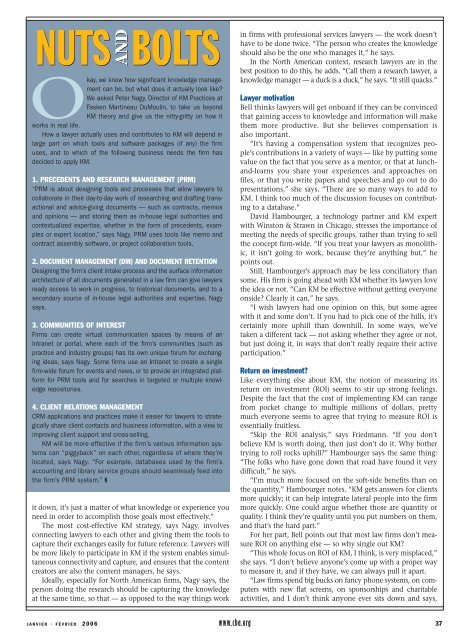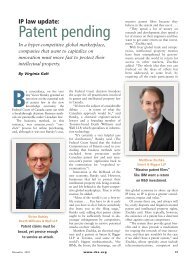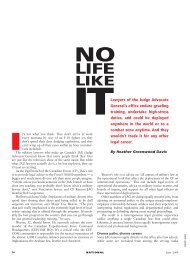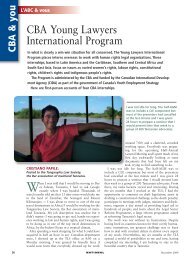The Canadian Bar Association - National (English) - July/August 2012
The Canadian Bar Association - National (English) - July/August 2012
The Canadian Bar Association - National (English) - July/August 2012
You also want an ePaper? Increase the reach of your titles
YUMPU automatically turns print PDFs into web optimized ePapers that Google loves.
NUTS BOLTS<br />
Okay, we know how significant knowledge management<br />
can be, but what does it actually look like?<br />
We asked Peter Nagy, Director of KM Practices at<br />
Fasken Martineau DuMoulin, to take us beyond<br />
KM theory and give us the nitty-gritty on how it<br />
works in real life.<br />
How a lawyer actually uses and contributes to KM will depend in<br />
large part on which tools and software packages (if any) the firm<br />
uses, and to which of the following business needs the firm has<br />
decided to apply KM.<br />
AND<br />
1. PRECEDENTS AND RESEARCH MANAGEMENT (PRM)<br />
“PRM is about designing tools and processes that allow lawyers to<br />
collaborate in their day-to-day work of researching and drafting transactional<br />
and advice-giving documents — such as contracts, memos<br />
and opinions — and storing them as in-house legal authorities and<br />
contextualized expertise, whether in the form of precedents, examples<br />
or expert location,” says Nagy. PRM uses tools like memo and<br />
contract assembly software, or project collaboration tools.<br />
2. DOCUMENT MANAGEMENT (DM) AND DOCUMENT RETENTION<br />
Designing the firm’s client intake process and the surface information<br />
architecture of all documents generated in a law firm can give lawyers<br />
ready access to work in progress, to historical documents, and to a<br />
secondary source of in-house legal authorities and expertise, Nagy<br />
says.<br />
3. COMMUNITIES OF INTEREST<br />
Firms can create virtual communication spaces by means of an<br />
Intranet or portal, where each of the firm’s communities (such as<br />
practice and industry groups) has its own unique forum for exchanging<br />
ideas, says Nagy. Some firms use an Intranet to create a single<br />
firm-wide forum for events and news, or to provide an integrated platform<br />
for PRM tools and for searches in targeted or multiple knowledge<br />
repositories.<br />
4. CLIENT RELATIONS MANAGEMENT<br />
CRM applications and practices make it easier for lawyers to strategically<br />
share client contacts and business information, with a view to<br />
improving client support and cross-selling.<br />
KM will be more effective if the firm’s various information systems<br />
can “piggyback” on each other, regardless of where they’re<br />
located, says Nagy. “For example, databases used by the firm’s<br />
accounting and library service groups should seamlessly feed into<br />
the firm’s PRM system.” N<br />
it down, it’s just a matter of what knowledge or experience you<br />
need in order to accomplish those goals most effectively.”<br />
<strong>The</strong> most cost-effective KM strategy, says Nagy, involves<br />
connecting lawyers to each other and giving them the tools to<br />
capture their exchanges easily for future reference. Lawyers will<br />
be more likely to participate in KM if the system enables simultaneous<br />
connectivity and capture, and ensures that the content<br />
creators are also the content managers, he says.<br />
Ideally, especially for North American firms, Nagy says, the<br />
person doing the research should be capturing the knowledge<br />
at the same time, so that — as opposed to the way things work<br />
JANVIER · FÉVRIER 2006 www.cba.org<br />
in firms with professional services lawyers — the work doesn’t<br />
have to be done twice. “<strong>The</strong> person who creates the knowledge<br />
should also be the one who manages it,” he says.<br />
In the North American context, research lawyers are in the<br />
best position to do this, he adds. “Call them a research lawyer, a<br />
knowledge manager — a duck is a duck,” he says. “It still quacks.”<br />
Lawyer motivation<br />
Bell thinks lawyers will get onboard if they can be convinced<br />
that gaining access to knowledge and information will make<br />
them more productive. But she believes compensation is<br />
also important.<br />
“It’s having a compensation system that recognizes people’s<br />
contributions in a variety of ways — like by putting some<br />
value on the fact that you serve as a mentor, or that at lunchand-learns<br />
you share your experiences and approaches on<br />
files, or that you write papers and speeches and go out to do<br />
presentations,” she says. “<strong>The</strong>re are so many ways to add to<br />
KM. I think too much of the discussion focuses on contributing<br />
to a database.”<br />
David Hambourger, a technology partner and KM expert<br />
with Winston & Strawn in Chicago, stresses the importance of<br />
meeting the needs of specific groups, rather than trying to sell<br />
the concept firm-wide. “If you treat your lawyers as monolithic,<br />
it isn’t going to work, because they’re anything but,” he<br />
points out.<br />
Still, Hambourger’s approach may be less conciliatory than<br />
some. His firm is going ahead with KM whether its lawyers love<br />
the idea or not. “Can KM be effective without getting everyone<br />
onside? Clearly it can,” he says.<br />
“I wish lawyers had one opinion on this, but some agree<br />
with it and some don’t. If you had to pick one of the hills, it’s<br />
certainly more uphill than downhill. In some ways, we’ve<br />
taken a different tack — not asking whether they agree or not,<br />
but just doing it, in ways that don’t really require their active<br />
participation.”<br />
Return on investment?<br />
Like everything else about KM, the notion of measuring its<br />
return on investment (ROI) seems to stir up strong feelings.<br />
Despite the fact that the cost of implementing KM can range<br />
from pocket change to multiple millions of dollars, pretty<br />
much everyone seems to agree that trying to measure ROI is<br />
essentially fruitless.<br />
“Skip the ROI analysis,” says Friedmann. “If you don’t<br />
believe KM is worth doing, then just don’t do it. Why bother<br />
trying to roll rocks uphill?” Hambourger says the same thing:<br />
“<strong>The</strong> folks who have gone down that road have found it very<br />
difficult,” he says.<br />
“I’m much more focused on the soft-side benefits than on<br />
the quantity,” Hambourger notes. “KM gets answers for clients<br />
more quickly; it can help integrate lateral people into the firm<br />
more quickly. One could argue whether those are quantity or<br />
quality. I think they’re quality until you put numbers on them,<br />
and that’s the hard part.”<br />
For her part, Bell points out that most law firms don’t measure<br />
ROI on anything else — so why single out KM?<br />
“This whole focus on ROI of KM, I think, is very misplaced,”<br />
she says. “I don’t believe anyone’s come up with a proper way<br />
to measure it, and if they have, we can always pull it apart.<br />
“Law firms spend big bucks on fancy phone systems, on computers<br />
with new flat screens, on sponsorships and charitable<br />
activities, and I don’t think anyone ever sits down and says,<br />
37








